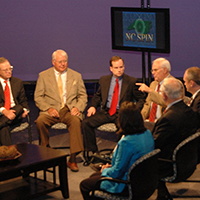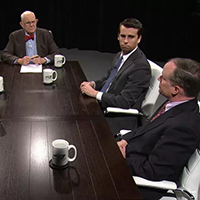National media coverage of health care policy and innovation in North Carolina often focuses on the most dramatic headlines. There’s the ongoing battle over whether to expand Medicaid coverage here, for example, and a recent “60 Minutes” report on Duke University researchers using an altered polio virus to shrink brain tumors.
Below the radar, however, other ground-breaking initiatives are under way with the potential to transform health and wellness in our state – and change the conversation about best practices nationally.
Mary Hall finds herself deeply enmeshed in one of the most ambitious of these efforts. And when she was sworn in 10 days ago as president of the national Society of Teachers of Family Medicine, she already knew two of her top priorities.
They’re the same as the ones she’s acting on now as chief academic officer at Charlotte-based Carolinas HealthCare System: 1) create a much stronger pipeline of primary care physicians and, 2) transform the way those physicians work.
52,000 doctors needed
Hall cites studies showing that health care in the United States would experience major increases in quality and decreases in cost if 40 to 50 percent of the nation’s doctors worked in primary care, coordinating and leading care at the ground level for patients of all ages. Right now, just 33 percent of doctors work in primary care (defined as family medicine, pediatrics and internal medicine). Trends show their numbers dropping to 17 percent over the next two decades as current physicians retire and medical students pursue more specialized residencies that typically offer higher salaries.
This is a looming crisis that’s slowly unfolded for a long time. In 1960, half of the physicians in the United States worked in primary care, according to the Council on Graduate Medical Education, and those numbers have steadily slipped. Factoring in population growth, aging and the expansion of insurance programs, a 2012 study published in the Annals of Family Medicine reported that by 2025 the United States will need an additional 52,000 primary care doctors.
“Primary care physicians are the foundation of an excellent healthcare system, and we’re in desperate need of them,” says Hall, a family medicine physician who also serves as associate dean at UNC School of Medicine Charlotte.
She’s involved now in a couple initiatives aimed at helping turn the tide.
Exposure to primary care track
At the UNC School of Medicine Charlotte, located at the Carolinas HealthCare campus, third-year medical students are part of an innovative experiential learning program. Rather than following the usual block system that exposes students to primary care and other fields in smaller chunks, these students work for extended periods in outpatient settings in the community, with half their time focused on primary care. The goal: giving them a close-up view of the powerful impact of high-quality primary care and piquing their interest in pursuing a residency in it.
For medical residents on the verge of starting their careers, there’s the I3 Population Health Collaborative. It’s a learning partnership of 27 academic primary care programs in North Carolina, South Carolina and Virginia that works with family medicine, internal medicine and pediatric primary care residents. The project aims to improve the patient experience and increase the overall clinical quality of work while also reducing costs.
Residents work in settings that expose them extensively to advanced primary care models with an emphasis on team-based care and continuous improvement. These teams engage a wide array of medical professionals – from medical directors and nurses to pharmacists and social workers – who work closely to drive enhancements in care across the three states. Periodic face-to-face meetings, regular webinars and the sharing of best practices and resources via a group website ensure constant communication and learning. It’s still too early to evaluate the full results of these efforts. But, in the meantime, medical residents are helping make an immediate positive impact on their current patients and preparing to provide patients with comprehensive primary care throughout their careers.
Initiatives like these bode well not just for the future of medicine but also for the future of our communities. The healthier residents are, the more opportunities they have to unleash their talent – and the more likely we are as a state to realize our full potential.
Christopher Gergen is CEO of Forward Impact and a fellow in Innovation and Entrepreneurship at Duke University. Stephen Martin is a director at the nonprofit Center for Creative Leadership. They can be reached at authors@bullcityforward.org and followed on Twitter through @cgergen.







